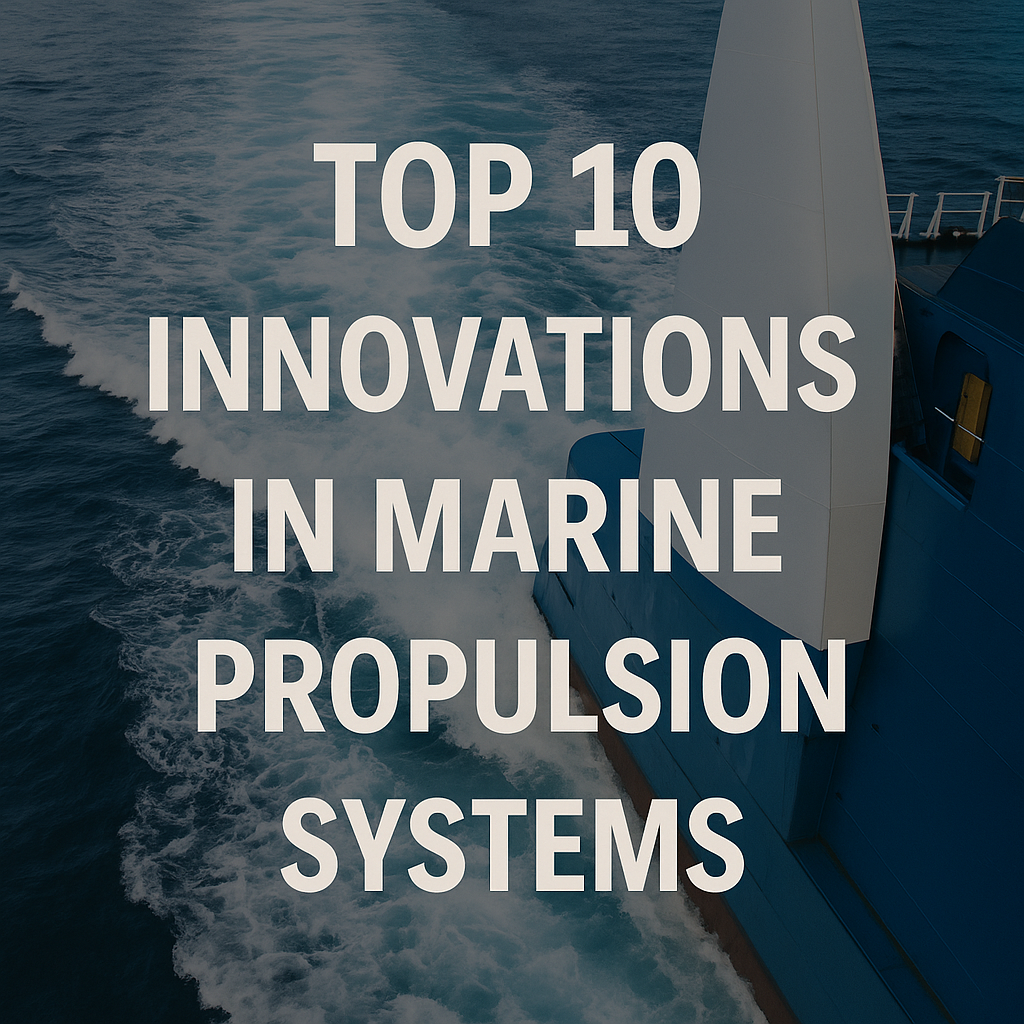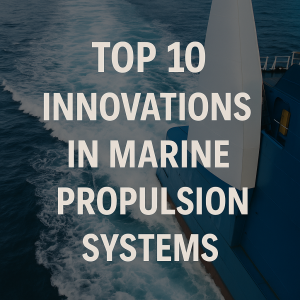Discover the top 10 innovations in marine propulsion systems revolutionizing the shipping industry. Explore advanced technologies, sustainability trends, and the future of maritime propulsion.
Why Marine Propulsion Innovation Matters in Modern Maritime Operations
In the past century, marine propulsion systems have evolved from coal-fired steam engines to advanced diesel and gas turbines. But today, the stakes are higher. As shipping faces mounting pressure to decarbonize, improve efficiency, and comply with stringent regulations, propulsion innovation is no longer optional—it’s essential.
The International Maritime Organization (IMO) has set an ambitious target: reduce greenhouse gas emissions from ships by at least 40% by 2030 and reach net zero by 2050. To meet these goals, shipowners, builders, and engineers are exploring next-generation propulsion technologies that are cleaner, smarter, and more adaptable.
This article explores the top 10 innovations in marine propulsion systems, backed by real-world applications, recent data, and expert insights. Whether you’re a marine engineer, naval architect, student, or shipping executive, understanding these advancements will help you navigate the industry’s future.
1. Hybrid Diesel-Electric Propulsion
Hybrid systems combine the reliability of traditional diesel engines with the efficiency of electric motors and batteries. These systems allow for flexible operation, switching between energy sources depending on load and operating mode.
Use Case: Ferries and offshore vessels benefit from silent, zero-emission electric mode while in port or during low-speed operations, reducing noise and exhaust.
Example: The Norwegian vessel Color Hybrid uses a battery pack of 5 MWh, enabling it to operate emission-free for up to 60 minutes in port.
2. LNG (Liquefied Natural Gas) Propulsion
LNG has emerged as a transitional fuel, offering reduced emissions of SOx, NOx, and particulate matter compared to heavy fuel oil.
Advantages:
-
20–30% reduction in CO₂ emissions
-
Compliance with MARPOL Annex VI and IMO 2020 sulfur cap
-
Improved air quality near ECAs (Emission Control Areas)
Real-World Adoption: CMA CGM’s Jacques Saadé, one of the largest LNG-powered container ships, boasts reduced GHG emissions by up to 20%.
Note: LNG still emits methane (a potent GHG), prompting further innovation toward bio-LNG and synthetic LNG.
3. Battery-Electric Propulsion Systems
Fully electric propulsion is most feasible for short-sea shipping, harbor craft, and inland waterways where range limitations are manageable.
Recent Developments:
-
Lithium-ion battery packs with high energy density
-
Advanced BMS (Battery Management Systems)
-
Shore-based charging infrastructure
Example: The Yara Birkeland, the world’s first fully electric and autonomous container ship, operates with zero emissions in Norwegian waters.
4. Hydrogen Fuel Cells
Fuel cells convert hydrogen into electricity with zero emissions, producing only water vapor and heat. This technology is gaining traction for deep-sea and auxiliary power applications.
Types Used in Shipping:
-
Proton Exchange Membrane (PEMFC)
-
Solid Oxide Fuel Cells (SOFC)
Projects to Watch:
-
Hydroville, a passenger ferry operating on compressed hydrogen
-
FLAGSHIPS Project, co-funded by the EU, deploying hydrogen vessels across Europe
5. Ammonia-Fueled Engines
Ammonia, containing no carbon, offers the potential for zero CO₂ emissions. It can be combusted directly or used in fuel cells.
Challenges:
-
Toxicity and safety in handling
-
Storage infrastructure
-
Engine compatibility
Collaborations: MAN Energy Solutions and Wärtsilä are developing ammonia-ready two-stroke engines scheduled for commercial availability by 2025–2026.
6. Wind-Assisted Propulsion Technologies
Wind propulsion is being reimagined using modern sail systems, such as:
-
Flettner rotors (rotating cylinders using the Magnus effect)
-
Rigid sails with automated controls
-
Kites that harness high-altitude winds
Case Study: The MV Afros bulk carrier saved up to 15% fuel using Flettner rotors installed by Anemoi Marine Technologies.
IMO Perspective: Wind-assist can be combined with other systems to meet EEDI and CII performance targets.
7. Nuclear Propulsion (for Specialized Vessels)
Although controversial, nuclear-powered propulsion offers unmatched endurance and zero operational emissions.
Used In:
-
Military vessels (submarines, aircraft carriers)
-
Icebreakers (e.g., Russia’s Arktika)
Future Outlook: Civilian nuclear propulsion remains limited due to high costs, complex regulations, and public perception—but new small modular reactors (SMRs) may change the equation.
8. Air Lubrication Systems
Air lubrication involves releasing a layer of microbubbles under the ship’s hull to reduce drag.
Benefits:
-
Up to 10% fuel savings
-
Lower emissions
-
Works in conjunction with traditional propulsion systems
Example: MOL’s Fujitrans World car carrier features Mitsubishi’s MALS (Mitsubishi Air Lubrication System), delivering proven fuel efficiency.
9. Advanced Propeller Designs
Propulsion efficiency starts at the screw. Innovations include:
-
Contra-rotating propellers for increased thrust
-
Ducted propellers (Kort nozzles) for low-speed vessels
-
Tip-fin and CLT (Contracted and Loaded Tip) designs
Bonus: Computational Fluid Dynamics (CFD) and 3D modeling now enable precise blade optimization during the design phase.
10. Artificial Intelligence and Propulsion Automation
AI is playing a growing role in propulsion management, allowing for:
-
Real-time engine tuning based on weather, speed, and load
-
Predictive maintenance
-
Fuel optimization algorithms
Platforms Include:
-
Wärtsilä’s Fleet Operations Solution (FOS)
-
ABB’s Ability Marine Advisory System
Result: Ships using AI-based propulsion optimization report fuel savings of up to 5–10% and enhanced voyage planning accuracy.
Case Study: The Maersk Decarbonization Strategy
Maersk’s goal to achieve net-zero carbon emissions by 2040 has accelerated its investment in green propulsion systems. The company has ordered a series of vessels that will operate on methanol, a cleaner-burning alternative already available at select global ports. With dual-fuel engines and flexible fuel pathways, these ships represent the next phase of propulsion evolution.
FAQ: Marine Propulsion Innovation
Q1: What is the most fuel-efficient propulsion system today?
A: It depends on vessel type. Hybrid-electric systems are efficient for short voyages, while optimized slow-speed two-stroke diesel engines remain efficient for long-haul shipping when combined with energy-saving devices.
Q2: Are wind-assisted propulsion systems practical for cargo ships?
A: Yes. Modern Flettner rotors and rigid sails have shown 5–20% fuel savings, especially on bulk carriers and RoRos.
Q3: Is nuclear propulsion viable for commercial shipping?
A: Technically yes, but widespread adoption is limited due to safety concerns, public perception, and regulatory complexity.
Q4: What role does AI play in propulsion systems?
A: AI helps optimize engine load, fuel mix, and routing to maximize efficiency and reduce emissions in real time.
Q5: Will ammonia or hydrogen become the dominant future fuel?
A: Both are strong contenders. Hydrogen is cleaner but harder to store; ammonia is denser and easier to handle but toxic. Market adoption will likely depend on safety, infrastructure, and fuel availability.
Conclusion
As the maritime industry sails into a new era of environmental responsibility and digital transformation, propulsion innovation stands at the helm. From clean fuels to smart automation, these top 10 technologies are not just futuristic—they’re already reshaping ship design, operations, and regulatory compliance.
By staying informed and adaptable, maritime professionals can help their vessels remain competitive, compliant, and climate-ready.
Call to Action: For propulsion case studies, compliance tools, and design benchmarks, visit our Marine Propulsion Technology Hub.
References
-
International Maritime Organization. (2023). IMO Strategy on Reduction of GHG Emissions. https://www.imo.org
-
MAN Energy Solutions. (2022). Future Fuels in Marine Propulsion. https://www.man-es.com
-
Wärtsilä. (2023). Hybrid and Electric Marine Solutions. https://www.wartsila.com
-
DNV. (2023). Maritime Forecast to 2050. https://www.dnv.com
-
ICS. (2022). Reducing CO₂ Emissions from Ships: A Guide for Shipowners. https://www.ics-shipping.org


